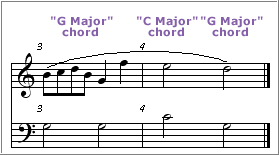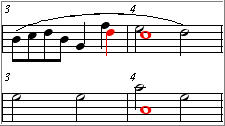Establishing chord progressions
So now we have four complete bars. What's next? Well,
another simple theory tip is that the
V chord wants to return to the I chord. If you look again
at the C Major scale chord chart, you will see that the V chord
is the G chord and the I chord
is the C chord.

That's why we were able to briefly go to the abbreviated
C chord (I chord) on
the downbeat of bar 4: it followed the implied G chord (V chord)
chord in bar 3.

Since the last chord of bar 4 feels like a G chord
(the V chord), we can go
back to the C chord (the I chord)
in bar 5. Again, the V chord
wants to go to the I chord - which means the
G chord wants to go to the C chord. And if you remember,
our piece begins with the C chord. So let's go back to the beginning
again. In fact, let's use the first two bars again,
since they worked so well together the first time.

So far, so good. Bars 1 and 2 sound fine when repeated
in bars 5 and 6. But if we continue to repeat bars from the beginning,
the music will sound too repetitive. Since we don't want to re-state bars
3 and 4 exactly the same as the first time, let's give them a slight variation
in bars 7 and 8. But how?
Well, let's look at bars 3 and 4 again:

With our last two bars
resolved, we've now completed an eight bar composition. Let's listen to
those final two bars in the context of the full piece:

That worked very well. Take another look at bars 3 and
4, and the changes we made to create bars 7 and 8. (The notes of bars
3 and 4 are in black. The changes we made to create bars 7 and 8 are in
red.):

|